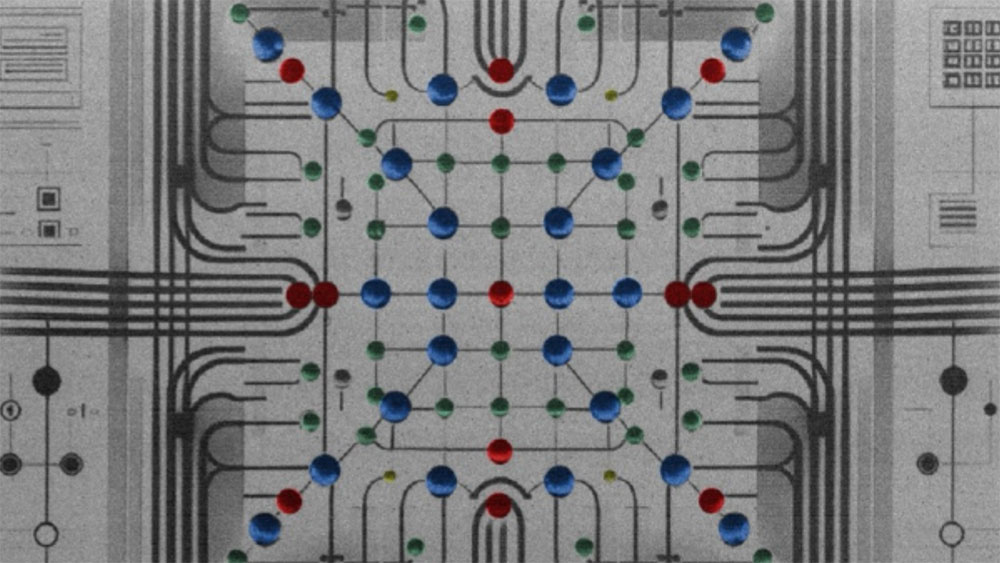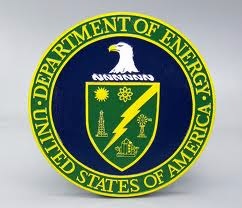From The DOE’s Brookhaven National Laboratory
5.9.24
Ajith Pattammattel
Yong Chu
Contact:
Denise Yazak
dyazak@bnl.gov
631-344-6371

BNL
A breakthrough in atomic-scale X-ray imaging, detecting the presence of just a few hundred gallium atoms inside an otherwise pure silicon crystal, is being celebrated at the University of Surrey (UK).
Spotting such tiny impurities could help build more efficient and powerful quantum computers.
Now, the team predicts that X-ray imaging will detect a single atom inside a solid sample within the next year or so.
In a regular chest X-ray, heavier and lighter elements show up differently. This allows us to see metal screws or bones. Density alters the contrast, which is how we can pick out air-filled lungs.
The Surrey scientists wondered how small a density the X-ray could detect.
They developed an experiment with colleagues at DESY (Germany), UCL (UK), and UWisconsin-Madison to find out. They used the X-ray facilities at the National Synchotron Light Source II [below] at Brookhaven National Laboratory.
At Surrey’s Ion Beam Centre, they implanted just 350 zeptogrammes of gallium atoms in an otherwise pure silicon crystal. That’s about a million billion times less than the mass of an ant or about a billion times less than that of a single cell.
Remarkably, the X-rays were sensitive enough to find the tiny cluster of gallium atoms.
“To detect such a tiny impurity deep within a silicon crystal has many exciting possibilities. We’re excited to see how much further we can push the detection limit of X-ray microscopes. It’s possible that they will be able to detect a single atom using this technique within the near future,” said Dr Yong Chu, Manager for the Imaging and Microscopy Program at NSLS-II.
The study is published in the journal Small Methods.
See the full article here .
Comments are invited and will be appreciated, especially if the reader finds any errors which I can correct.

five-ways-keep-your-child-safe-school-shootings
Please help promote STEM in your local schools.
![]()
Stem Education Coalition

One of ten national laboratories overseen and primarily funded by the The DOE Office of Science, The DOE’s Brookhaven National Laboratory conducts research in the physical, biomedical, and environmental sciences, as well as in energy technologies and national security. Brookhaven Lab also builds and operates major scientific facilities available to university, industry and government researchers. The Laboratory’s almost 3,000 scientists, engineers, and support staff are joined each year by more than 5,000 visiting researchers from around the world. Brookhaven is operated and managed for DOE’s Office of Science by Brookhaven Science Associates, a limited-liability company founded by Stony Brook University the largest academic user of Laboratory facilities, and Battelle, a nonprofit, applied science and technology organization.
Research at BNL specializes in nuclear and high energy physics, energy science and technology, environmental and bioscience, nanoscience and national security. The 5300 acre campus contains several large research facilities, including the Relativistic Heavy Ion Collider [below] and National Synchrotron Light Source II [below]. A number of Nobel prizes have been awarded for work conducted at Brookhaven lab.
BNL is staffed by approximately 2,750 scientists, engineers, technicians, and support personnel, and hosts 4,000 guest investigators every year. The laboratory has its own police station, fire department, and ZIP code (11973). In total, the lab spans a 5,265-acre (21 km^2) area that is mostly coterminous with the hamlet of Upton, New York. BNL is served by a rail spur operated as-needed by the New York and Atlantic Railway. Co-located with the laboratory is the Upton, New York, forecast office of the National Weather Service.
Major programs
Although originally conceived as a nuclear research facility, Brookhaven Lab’s mission has greatly expanded. Its foci are now:
Nuclear and high-energy physics
Physics and chemistry of materials
Environmental and climate research
Nanomaterials
Energy research
Nonproliferation
Structural biology
Accelerator physics
Operation
Brookhaven National Lab was originally owned by the Atomic Energy Commission and is now owned by that agency’s successor, the United States Department of Energy (DOE). DOE subcontracts the research and operation to universities and research organizations. It is currently operated by Brookhaven Science Associates LLC, which is an equal partnership of Stony Brook University and Battelle Memorial Institute. From 1947 to 1998, it was operated by Associated Universities, Inc. (AUI), but AUI lost its contract in the wake of two incidents: a 1994 fire at the facility’s high-beam flux reactor that exposed several workers to radiation and reports in 1997 of a tritium leak into the groundwater of the Long Island Central Pine Barrens on which the facility sits.
Foundations
Following World War II, the US Atomic Energy Commission was created to support government-sponsored peacetime research on atomic energy. The effort to build a nuclear reactor in the American northeast was fostered largely by physicists Isidor Isaac Rabi and Norman Foster Ramsey Jr., who during the war witnessed many of their colleagues at Columbia University leave for new remote research sites following the departure of the Manhattan Project from its campus. Their effort to house this reactor near New York City was rivalled by a similar effort at the Massachusetts Institute of Technology to have a facility near Boston, Massachusetts. Involvement was quickly solicited from representatives of northeastern universities to the south and west of New York City such that this city would be at their geographic center. In March 1946 a nonprofit corporation was established that consisted of representatives from nine major research universities — Columbia University, Cornell University, Harvard University, Johns Hopkins University, Massachusetts Institute of Technology, Princeton University, University of Pennsylvania, University of Rochester, and Yale University.
Out of 17 considered sites in the Boston-Washington corridor, Camp Upton on Long Island was eventually chosen as the most suitable in consideration of space, transportation, and availability. The camp had been a training center from the US Army during both World War I and World War II. After the latter war, Camp Upton was deemed no longer necessary and became available for reuse. A plan was conceived to convert the military camp into a research facility.
On March 21, 1947, the Camp Upton site was officially transferred from the U.S. War Department to the new U.S. Atomic Energy Commission (AEC), predecessor to the U.S. Department of Energy (DOE).
Research and facilities
Reactor history
In 1947 construction began on the first nuclear reactor at Brookhaven, the Brookhaven Graphite Research Reactor. This reactor, which opened in 1950, was the first reactor to be constructed in the United States after World War II. The High Flux Beam Reactor operated from 1965 to 1999. In 1959 Brookhaven built the first US reactor specifically tailored to medical research, the Brookhaven Medical Research Reactor, which operated until 2000.
Accelerator history
In 1952 Brookhaven began using its first particle accelerator, the Cosmotron. At the time the Cosmotron was the world’s highest energy accelerator, being the first to impart more than 1 GeV of energy to a particle.

The Cosmotron was retired in 1966, after it was superseded in 1960 by the new Alternating Gradient Synchrotron (AGS).
 BNL Alternating Gradient Synchrotron (AGS).
BNL Alternating Gradient Synchrotron (AGS).
The AGS was used in research that resulted in 3 Nobel prizes, including the discovery of the muon neutrino, the charm quark, and CP violation.
In 1970 in BNL started the ISABELLE project to develop and build two proton intersecting storage rings.
The groundbreaking for the project was in October 1978. In 1981, with the tunnel for the accelerator already excavated, problems with the superconducting magnets needed for the ISABELLE accelerator brought the project to a halt, and the project was eventually cancelled in 1983.

After ISABELLE’S cancellation, physicist at BNL proposed that the excavated tunnel and parts of the magnet assembly be used in another accelerator. In 1984 the first proposal for the accelerator now known as the Relativistic Heavy Ion Collider (RHIC)[below] was put forward. The construction got funded in 1991 and RHIC has been operational since 2000. One of the world’s only two operating heavy-ion colliders, RHIC is as of 2010 the second-highest-energy collider after the Large Hadron Collider (CH). RHIC is housed in a tunnel 2.4 miles (3.9 km) long and is visible from space.
On January 9, 2020, it was announced by Paul Dabbar, undersecretary of the US Department of Energy Office of Science, that the BNL eRHIC design has been selected over the conceptual design put forward by DOE’s Thomas Jefferson National Accelerator Facility [Jlab] as the future Electron–ion collider (EIC)

In addition to the site selection, it was announced that the BNL EIC had acquired CD-0 from the Department of Energy. BNL’s eRHIC design proposes upgrading the existing Relativistic Heavy Ion Collider, which collides beams light to heavy ions including polarized protons, with a polarized electron facility, to be housed in the same tunnel.
Other discoveries
In 1958, Brookhaven scientists created one of the world’s first video games, Tennis for Two. In 1968 Brookhaven scientists patented Maglev, a transportation technology that utilizes magnetic levitation.
Major facilities
Relativistic Heavy Ion Collider (RHIC), which was designed to research quark–gluon plasma and the sources of proton spin. Until 2009 it was the world’s most powerful heavy ion collider. It is the only collider of spin-polarized protons.
Center for Functional Nanomaterials (CFN), used for the study of nanoscale materials.
BNL National Synchrotron Light Source II, Brookhaven’s newest user facility, opened in 2015 to replace the National Synchrotron Light Source (NSLS), which had operated for 30 years. NSLS was involved in the work that won the 2003 and 2009 Nobel Prize in Chemistry.
Alternating Gradient Synchrotron, a particle accelerator that was used in three of the lab’s Nobel prizes.
Accelerator Test Facility, generates, accelerates and monitors particle beams.
Tandem Van de Graaff, once the world’s largest electrostatic accelerator.
Computational Science resources, including access to a massively parallel Blue Gene series supercomputer that is among the fastest in the world for scientific research, run jointly by Brookhaven National Laboratory and Stony Brook University-SUNY.
Interdisciplinary Science Building, with unique laboratories for studying high-temperature superconductors and other materials important for addressing energy challenges.
NASA Space Radiation Laboratory, where scientists use beams of ions to simulate cosmic rays and assess the risks of space radiation to human space travelers and equipment.
Off-site contributions
It is a contributing partner to the ATLAS experiment, one of the four detectors located at the The European Organization for Nuclear Research [La Organización Europea para la Investigación Nuclear][Organization européenne pour la recherche nucléaire] [Europäische Organization für Kernforschung](CH)[CERN] Large Hadron Collider(LHC). Credit: CERN.


It is currently operating at The European Organization for Nuclear Research [La Organización Europea para la Investigación Nuclear][Organization européenne pour la recherche nucléaire] [Europäische Organization für Kernforschung](CH) [CERN] near Geneva, Switzerland.
Brookhaven was also responsible for the design of Spallation Neutron Source at the DOE’s Oak Ridge National Laboratory, Tennessee.

Brookhaven plays a role in a range of neutrino research projects around the world, including the Daya Bay Neutrino Experiment (CN) nuclear power plant, approximately 52 kilometers northeast of Hong Kong and 45 kilometers east of Shenzhen, China.















